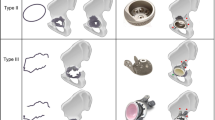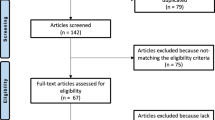Abstract
Purpose
The purpose of the present study was to: (1) investigate the variation of both acetabular and femoral component version in a large series of consecutive primary THA patients, and (2) to better define the associations of acetabular and femoral component alignment and clinical factors with subsequent hip dislocation in those patients.
Methods
We analyzed CT scans of 1,555 consecutive primary THAs and measured version of the components. We also documented the frequency and direction of subsequent dislocation as well as femoral head size, posterior tissue repair, any history of previous hip surgery, and gender.
Results
The dislocation rate after THA was 3.22 %. The dislocation risk was 1.9 times higher if cup anteversion was not between 10° and 30°. Compared to hips that did not dislocate, those that experienced anterior dislocation had a significantly greater combined anteversion; those that dislocated posteriorly had a significantly smaller combined anteversion. Hips with previous rotational acetabular osteotomy or head size smaller than 28 mm correlated with an increased dislocation rate.
Conclusion
The dislocation risk could be higher if cup anteversion was not between 10° and 30°. Greater combined anteversion could be a risk factor of anterior dislocation, and posterior dislocation could be more common in smaller combined anteversion.




Similar content being viewed by others
References
Caton JH, Prudhon JL, Ferreira A, Aslanian T, Verdier R (2014) A comparative and retrospective study of three hundred and twenty primary Charnley type hip replacements with a minimum follow up of ten years to assess whether a dual mobility cup has a decreased dislocation risk. Int Orthop 38(6):1125–1129
Hailer NP, Weiss RJ, Stark A, Kärrholm J (2012) The risk of revision due to dislocation after total hip arthroplasty depends on surgical approach, femoral head size, sex, and primary diagnosis. An analysis of 78,098 operations in the Swedish Hip Arthroplasty Register. Acta Orthop 83(5):442–448
Howie DW, Holubowycz OT, Middleton R (2012) Large femoral heads decrease the incidence of dislocation after total hip arthroplasty: a randomized controlled trial. J Bone Joint Surg Am 94(12):1095–1102
Jolles BM, Zangger P, Leyvraz PF (2002) Factors predisposing to dislocation after primary total hip arthroplasty: a multivariate analysis. J Arthroplasty 17(3):282–288
Leichtle UG, Leichtle CI, Taslaci F, Reize P, Wünschel M (2013) Dislocation after total hip arthroplasty: risk factors and treatment options. Acta Orthop Traumatol Turc 47(2):96–103
Lewinnek GE, Lewis JL, Tarr R, Compere CL, Zimmerman JR (1978) Dislocations after total hip replacement arthroplasties. J Bone Joint Surg Am 60(2):217–220
Minoda Y, Kadowaki T, Kim M (2006) Acetabular component orientation in 834 total hip arthroplasties using a manual technique. Clin Orthop Relat Res 445:186–191
Soohoo NF, Farng E, Lieberman JR, Chambers L, Zingmond DS (2010) Factors that predict short-term complication rates after total hip arthroplasty. Clin Orthop Relat Res 468(9):2363–2371
Wang L, Trousdale RT, Ai S, An KN, Dai K, Morrey BF (2012) Dislocation after total hip arthroplasty among patients with developmental dysplasia of the hip. J Arthroplasty 27(5):764–769
Fujishiro T, Hayashi S, Kanzaki N, Hashimoto S, Kurosaka M, Kanno T, Masuda T (2014) Computed tomographic measurement of acetabular and femoral component version in total hip arthroplasty. Int Orthop 38(5):941–946
Hayashi S, Nishiyama T, Fujishiro T, Hashimoto S, Kanzaki N, Nishida K, Kuroda R, Kurosaka M (2013) Evaluation of the accuracy of femoral component orientation by the CT-based fluoro-matched navigation system. Int Orthop 37(6):1063–1068
Zhang J, Wang L, Mao Y, Li H, Ding H, Zhu Z (2014) The use of combined anteversion in total hip arthroplasty for patients with developmental dysplasia of the hip. J Arthroplasty 29(3):621–625
Nakashima Y, Hirata M, Akiyama M, Itokawa T, Yamamoto T, Motomura G, Ohishi M, Hamai S, Iwamoto Y (2014) Combined anteversion technique reduced the dislocation in cementless total hip arthroplasty. Int Orthop 38(1):27–32
Pierchon F, Pasquier G, Cotten A, Fontaine C, Clarisse J, Duquennoy A (1994) Causes of dislocation of total hip arthroplasty. CT study of component alignment. J Bone Joint Surg (Br) 76(1):45–48
Sutherland CJ, Wilde AH, Borden LS, Marks KE (1982) A ten-year follow-up of one hundred consecutive Müller curved-stem total hip-replacement arthroplasties. J Bone Joint Surg Am 64(7):970–982
Xie J, Naito M, Maeyama A (2010) Evaluation of acetabular versions after a curved periacetabular osteotomy for dysplastic hips. Int Orthop 34(4):473–477
Hartig-Andreasen C, Stilling M, Søballe K, Thillemann TM, Troelsen A (2014) Is cup positioning challenged in hips previously treated with periacetabular osteotomy? J Arthroplasty 29(4):763–768
Woo RY, Morrey BF (1982) Dislocations after total hip arthroplasty. J Bone Joint Surg Am 64(9):1295–1306
Craiovan B, Renkawitz T, Weber M, Grifka J, Nolte L, Zheng G (2014) Is the acetabular cup orientation after total hip arthroplasty on a two dimension or three dimension model accurate? Int Orthop 38(10):2009–2015
Jingushi S, Ohfuji S, Sofue M et al (2010) Multiinstitutional epidemiological study regarding osteoarthritis of the hip in Japan. J Orthop Sci 15(5):626–631
Author information
Authors and Affiliations
Corresponding author
Rights and permissions
About this article
Cite this article
Fujishiro, T., Hiranaka, T., Hashimoto, S. et al. The effect of acetabular and femoral component version on dislocation in primary total hip arthroplasty. International Orthopaedics (SICOT) 40, 697–702 (2016). https://doi.org/10.1007/s00264-015-2924-2
Received:
Accepted:
Published:
Issue Date:
DOI: https://doi.org/10.1007/s00264-015-2924-2




